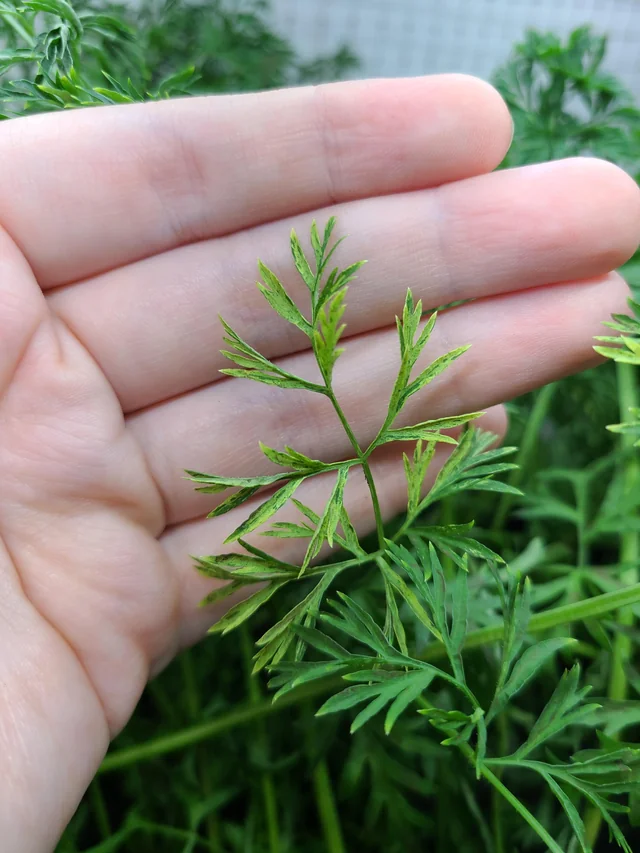Ah, the world of gardening surprises on Reddit! 🥕 One Reddit user had quite the unexpected twist in their vegetable patch: a variegated carrot. Here’s how the Reddit community reacted:
The Discovery: The user named “TheGrinningOwl” shared a photo of their unique carrot, asking if it was a good thing, and whether the whole carrot would turn out the same way. It’s always exciting when Mother Nature throws in a plot twist.
Expert Insights: The-greenest-thumb, who happens to be the original poster, offered some insightful wisdom. They explained that the variegation, although cool to look at, might not be ideal for vegetables. Variegation means some parts of the plant can’t photosynthesize as effectively. They pointed out that if more of the carrot was variegated, it could potentially slow down growth or harm the plant. The verdict? Variegation is more sought after in ornamental plants than in veggies.
Creative Imagination: Other users got a little whimsical. Someone fantasized about a colossal carrot tree, which would indeed be a sight to behold. And another dreamt of a striped yellow and white carrot – a real visual treat for the garden!
Source:
https://www.reddit.com/r/gardening/comments/17d5jxg/one_of_my_carrots_is_variegated/
Now, let’s dig a little deeper (pun intended). Variegation in plants refers to the presence of different colors or markings in their leaves, stems, or other parts. It’s often associated with ornamental plants or houseplants to make them more visually appealing. However, in vegetables, it’s not necessarily a plus.
Here’s why: Variegated areas on a plant can’t harness sunlight efficiently for photosynthesis, which is essential for growth. In this case, the carrot’s root will likely be a typical orange, as variegation tends to affect leaves and stems more than roots.
So, while variegated carrots are a fascinating quirk of nature, they might not make the tastiest addition to your salad. But they sure can be a fun conversation starter for fellow garden enthusiasts! 🌱🥕🗨️
Contents
Variegation in Plants: Nature’s Artistry
Variegation in plants is like nature’s way of adding an artistic touch to the green canvas of leaves. It’s the occurrence of distinct patterns, colors, or markings on plant foliage, stems, or even flowers. These deviations from the standard green can be stripes, splotches, marbling, or borders of various hues, including white, yellow, red, or pink. Variegation can occur naturally due to genetic mutations, but it can also be intentionally bred or cultivated for ornamental purposes.
The Fascination of Variegation:
- Visual Appeal: Variegated plants are popular in ornamental gardening and landscaping because they add visual interest and diversity. They break the monotony of solid green and draw the eye with their unique patterns and colors.
- Garden Design: Landscape architects and garden enthusiasts often use variegated plants to create contrast, focal points, or to brighten up shaded areas. They can bring harmony to the overall garden design.
- Indoor Plants: Variegated houseplants have become trendy for interior décor. Their striking foliage adds a pop of color to homes and offices. Some popular choices include the variegated monstera, pothos, and snake plant.
- Collector’s Items: Some gardeners and plant collectors seek rare variegated specimens as prized additions to their collections. These unique variations can become quite valuable within the horticultural community.
The Science of Variegation:
Variegation can result from several factors, including:
- Genetic Mutations: In many cases, variegation is a genetic mutation. The affected cells are unable to produce chlorophyll or other pigments properly, resulting in the distinctive colors.
- Environmental Stress: External factors like temperature fluctuations, pests, or nutrient imbalances can sometimes cause variegation in plants. For example, cold-induced variegation can make certain evergreen shrubs develop white or yellow edges on their leaves during the winter.
- Chimeras: Some variegated plants are chimeras, which means they have two or more genetically distinct cell layers. These different layers can lead to unique variegation patterns.
Challenges of Variegation:
While variegation adds allure to plants, it comes with challenges. Variegated areas typically have reduced chlorophyll, which means they can’t photosynthesize as efficiently as fully green parts. As a result, these areas may grow more slowly, be more susceptible to diseases, or even die off if they can’t meet their energy needs.
In summary, variegation in plants is like a work of art in your garden or home. While it may not always be functional for the plant, it certainly adds a fascinating and aesthetically pleasing dimension to the world of horticulture. Whether you’re admiring a variegated houseplant, ornamental garden shrub, or a quirky variegated carrot, you’re witnessing nature’s brushstrokes of color and pattern. 🌱🎨🍀


